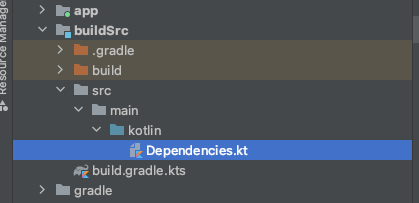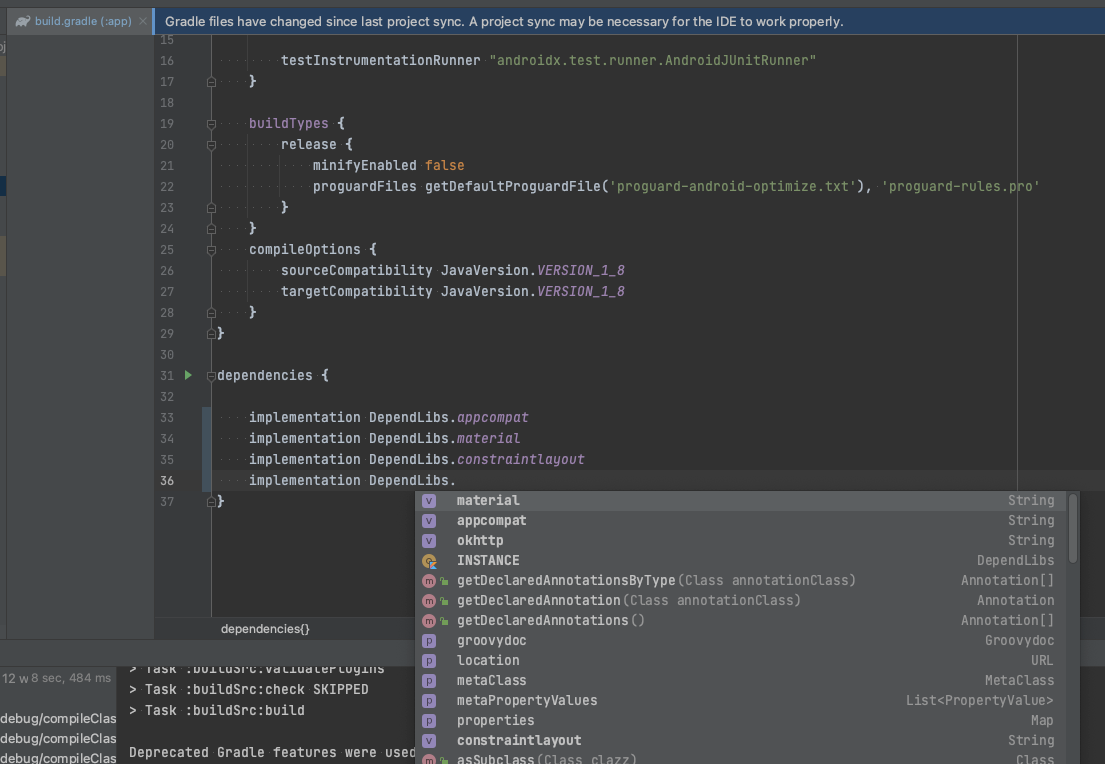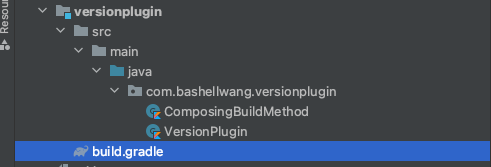背景 随着项目的发展扩张,项目区分多个 module 的做法越来越常见,同时项目中的依赖也越来越多,不同 module 引入的版本也不一致。有必要对项目中的依赖做梳理,达到统一管理、单独配置,版本号统一的目的。
gradle 依赖管理的一些方案 gradle 随着版本的发展,也不断涌现出一些不同的方案。包括:原始手动管理、extra 扩展管理、buildSrc 方案、composing build 方案以及 gradle 7.0 新出的 version catalog 等。
原始手动管理 手动管理的方式如下所示,自己引入需要的库,该方法最直观简单,但是在每次升级依赖库时需要做大量手动修改调整;同时不同 module 中容易存在重复的配置,且不容易管理版本更新。
1 2 3 4 5 6 dependencies { implementation 'androidx.appcompat:appcompat:1.3.1' implementation 'com.google.android.material:material:1.4.0' implementation 'androidx.constraintlayout:constraintlayout:2.1.1' implementation 'com.squareup.okhttp3:okhttp:4.9.2' }
google 在配置项目全局属性 中推荐这种管理方式。
在根目录下build.gradle中,添加ext代码块
1 2 3 4 5 6 7 8 9 10 11 12 13 ext { appcompatVer = "1.3.1" materialVer = "1.4.0" constraintlayoutVer = "2.1.1" okhttpVer = "4.9.2" dependencies = [ appcompat : "androidx.appcompat:appcompat:$appcompatVer", material : "com.google.android.material:material:$materialVer", constraintlayout: "androidx.constraintlayout:constraintlayout:$constraintlayoutVer", okhttp : "com.squareup.okhttp3:okhttp:$okhttpVer" ] }
在 module 目录下 build.gradle 中引入使用
1 2 3 4 5 6 dependencies { implementation rootProject.ext.dependencies.appcompat implementation rootProject.ext.dependencies.material implementation rootProject.ext.dependencies.constraintlayout implementation rootProject.ext.dependencies.okhttp }
这种方法比手动管理好了很多,可以做到统一版本号,统一管理;但是他也有缺点,就是在 IDE 中无法关联自动补全,同时 ext 里依赖项太多时,这个文件会变得很长。可以参考 使用循环优化Gradle依赖管理 处理。
buildSrc + Kotlin 上面介绍的方法,不支持代码提示,不支持 IDE 跳转,在多模块开发时相同的依赖需要复制粘贴,使用 buildSrc +Kotlin 可以解决这个问题。
gradle 在运行时会去检查是否存在 buildSrc 的目录,如果有的话,gradle 会自动编译并测试这段代码,并将其放入构建脚本的路径中。对于多项目构建,只能有一个 buildSrc 目录,它位于 gradle 根目录下的一个目录。
根目录下创建 buildSrc 目录 新建文件 build.gradle.kts 文件内容如下,同步 gradle
1 2 3 4 5 6 7 plugins { `kotlin-dsl` } repositories { // 必不可少 jcenter() }
创建 /src/main/kotlin/Dependencies.kt 文件内容如下
1 2 3 4 5 6 7 8 9 10 11 12 13 object Versions { const val appcompatVer = "1.3.1" const val materialVer = "1.4.0" const val constraintlayoutVer = "2.1.1" const val okhttpVer = "4.9.2" } object DependLibs { const val appcompat = "androidx.appcompat:appcompat:${Versions.appcompatVer}" const val material = "com.google.android.material:material:${Versions.materialVer}" const val constraintlayout = "androidx.constraintlayout:constraintlayout:${Versions.constraintlayoutVer}" const val okhttp = "com.squareup.okhttp3:okhttp:${Versions.okhttpVer}" }
在 module 中的 build.gradle 中引用,如下所示。
1 2 3 4 5 6 dependencies { implementation DependLibs.appcompat implementation DependLibs.material implementation DependLibs.constraintlayout implementation DependLibs.okhttp }
代码支持跳转,也可以支持自动补全,如下图所示
Composing build buildSrc 在依赖更新时会重新构建整个项目,是对全局所有 module 的配置,因此构建速度较慢;有没有既满足自动补全、单击跳转又在依赖更新时不重新构建整个项目的方法呢。答案是使用 Composing Build
Composing build又称 复合构建,指的是包含其它构建的构建。有点类似于 gradle 多项目构建,不同于独立项目,它是包含包括settings.gradle等配置文件在内的整个完整项目构建。
包含在复合构建中的构建被称为包含构建,包含的构建不与复合构建或其他包含的构建共享任何配置。每个包含的构建都是独立配置和执行的。
新建一个 module,只保留 src/main 下代码源文件和 build.gradle 文件,其余均删除,如图所示:
其中 VersionPlugin 为继承 Plugin 的实现类,代码空实现即可
1 2 3 4 5 class VersionPlugin : Plugin<Project> { override fun apply(target: Project) { } }
ComposingBuildMethod.kt 为定义依赖版本信息类,代码如下:
1 2 3 4 5 6 7 8 9 10 11 12 13 14 15 16 class ComposingBuildMethod { object Versions { const val appcompatVer = "1.3.1" const val materialVer = "1.4.0" const val constraintlayoutVer = "2.1.1" const val okhttpVer = "4.9.2" } object DependLibs { const val appcompat = "androidx.appcompat:appcompat:${Versions.appcompatVer}" const val material = "com.google.android.material:material:${Versions.materialVer}" const val constraintlayout = "androidx.constraintlayout:constraintlayout:${Versions.constraintlayoutVer}" const val okhttp = "com.squareup.okhttp3:okhttp:${Versions.okhttpVer}" } }
最后,build.gradle 中修改如下所示:
1 2 3 4 5 6 7 8 9 10 11 12 13 14 15 16 17 18 19 20 21 22 23 24 25 26 27 28 29 30 31 32 33 34 35 36 37 38 39 40 41 42 43 44 45 buildscript { repositories { jcenter() } dependencies { // 因为使用的 Kotlin 需要需要添加 Kotlin 插件 classpath "org.jetbrains.kotlin:kotlin-gradle-plugin:1.3.72" } } apply plugin: 'kotlin' apply plugin: 'java-gradle-plugin' repositories { // 需要添加 jcenter 否则会提示找不到 gradlePlugin jcenter() } dependencies { implementation gradleApi() implementation "org.jetbrains.kotlin:kotlin-stdlib-jdk8:1.3.72" } compileKotlin { kotlinOptions { jvmTarget = "1.8" } } compileTestKotlin { kotlinOptions { jvmTarget = "1.8" } } gradlePlugin { plugins { version { // 在 app 模块需要通过 id 引用这个插件 id = 'com.bashellwang.versionplugin' // 实现这个插件的类的路径 implementationClass = 'com.bashellwang.versionplugin.VersionPlugin' } } }
然后,在 setting.gradle 中使用 includeBuild 引用该 module。
1 includeBuild 'versionplugin'
最终在需要使用的 module,即 app module 下的 build.gradle 中引用该插件并使用即可。
1 2 3 4 5 6 7 8 9 10 11 12 plugins { id 'com.bashellwang.versionplugin' } ... dependencies{ // composing build 引用 implementation ComposingBuildMethod.DependLibs.appcompat implementation ComposingBuildMethod.DependLibs.material implementation ComposingBuildMethod.DependLibs.constraintlayout implementation ComposingBuildMethod.DependLibs.okhttp }
Version Catalogs 官方在 Gradle7.0 推出了一个新特性,可以使用 Catalog 统一依赖版本,它有以下特点:
对于每一个 catalog,gradle 可以生成类型安全的访问器方便在 IDE 中自动补全(注:实测在 build.gradle 中暂未实现,不确定是用法问题还是功能开发中)
catalog 对所有 module 可见,可以方便统一管理版本依赖
catalog 可以声明 bundles 依赖,就是经常一起使用的依赖的组合
catalog 支持依赖版本号与版本名分割,使用 version refrerences 可以在不同依赖之间共享版本号
因为 catalog 还是一个在孵化中的功能,因此要使用时需要在 setting.gradle 中开启功能预览
1 enableFeaturePreview('VERSION_CATALOGS')
然后新建一个 toml 文件,里面是一些版本依赖相关信息,比如:
1 2 3 4 5 6 7 8 9 10 11 12 13 14 15 [versions] groovy = "3.0.5" checkstyle = "8.37" compilesdk = "30" targetsdk = "30" [libraries] retrofit = "com.squareup.retrofit2:retrofit:2.9.0" groovy-core = { module = "org.codehaus.groovy:groovy", version.ref = "groovy" } groovy-json = { module = "org.codehaus.groovy:groovy-json", version.ref = "groovy" } groovy-nio = { module = "org.codehaus.groovy:groovy-nio", version.ref = "groovy" } commons-lang3 = { group = "org.apache.commons", name = "commons-lang3", version = { strictly = "[3.8, 4.0[", prefer="3.9" } } [bundles] groovy = ["groovy-core", "groovy-json", "groovy-nio"]
之后在 setting.gradle 中进行声明后即可使用:
1 2 3 4 5 6 7 dependencyResolutionManagement { versionCatalogs { cataloglibs { from(files("libs.versions.toml")) } } }
在 app 下的 build.gradle 文件中使用
1 2 3 4 5 // gradle catalog 引用 implementation cataloglibs.retrofit implementation cataloglibs.groovy.core implementation cataloglibs.groovy.json implementation cataloglibs.groovy.nio
源码地址 GitHub
总结 本文对常见依赖管理的几种方式进行了总结梳理,并初步体验了 gradle 7.0 新出的版本管理方式 catalog,项目可根据实际情况选择使用。
参考


